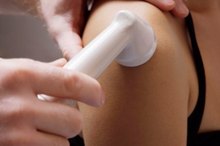Muscle Testing for Allergies
Allergies are your body’s response to certain types of chemicals and substances. You may suspect that you are allergic to certain particles, such as pollen. In order to accurately determine what you are allergic to, you must undergo testing. Muscle testing, also known as applied kinesiology, is an alternative method of allergy testing 1. According to the Surrey Allergy Clinic, muscle testing was founded by in 1964 by the American physician John Goodhart 1. However, kinesiology is not a practice adopted by traditional medical doctors.
If you are experiencing serious medical symptoms, seek emergency treatment immediately.
Function
Applied kinesiology is a method used by acupuncturists, chiropractors and some physicians to find if your muscles weaken when your body is exposed to certain toxins and allergens. Allergy Escape explains that muscle testing helps to identify a cause of imbalance between your body’s major muscles and organs 1.
Features
How to Get Rid of Belly Fat Using a Muscle Stimulator
Learn More
Muscle testing is performed while you hold a vial containing a given allergy 1. For example, the vial would be filled with an extract of maple tree pollen if you want to test for that particular allergen. The Surrey Allergy Clinic reports that some practitioners also use an antidote to help determine the accuracy of the initial test 2.
Procedure
According to Allergy Escape, the test is performed while you hold the vial in front of certain areas of your body. These include the thymus gland, your reproductive gland above the pelvis, the spleen and the liver. As you stand holding the vial with one hand, the practitioner faces you and lifts the opposite arm out to your side. She will then test your muscles of the arm by placing pressure on them with her hands. It is assumed that you are allergic to a particular allergen if your arm muscles weaken during the test.
- According to Allergy Escape, the test is performed while you hold the vial in front of certain areas of your body.
- It is assumed that you are allergic to a particular allergen if your arm muscles weaken during the test.
Evidentiary Support
Allergy Shot Side Effects
Learn More
The Surrey Allergy Clinic explains that there is not enough scientific evidence to support muscle testing as a reliable type of allergy assessment 12. This is partially due to the fact that each test is different, depending upon the professional conducting the test. Some users utilize magnets in conjunction with the vials in order to gain a greater response. Such variations in testing make the scientific evaluation of muscle testing difficult.
- The Surrey Allergy Clinic explains that there is not enough scientific evidence to support muscle testing as a reliable type of allergy assessment 1.
Considerations
Conventional testing by an allergist is typically conducted through skin-prick tests. During such a test, a small liquid sample of a type of allergen is inserted into your skin. After 15 to 20 minutes, your skin is evaluated for a reaction. A large red bump is indicative of an allergy intolerance. For example, if you are allergic to ragweed, your body releases histamine and produces the reaction. During muscle tests, your body does not have the opportunity to react in such a matter; therefore, the tests may not be as accurate as conventional tests.
- Conventional testing by an allergist is typically conducted through skin-prick tests.
- After 15 to 20 minutes, your skin is evaluated for a reaction.
Related Articles
References
- Allergy Escape: How to Perform Muscle Testing
- Surrey Allergy Clinic, London: Allergy Tests of No Proven Value
- Asthma and Allergy Foundation of American. Allergy diagnosis. Updated October 2015.
- American College of Allergy, Asthma, & Immunology. Allergy testing.
- American College of Allergy, Asthma, & Immunology. Skin test. Updated April 16, 2018.
- Birch K, Pearson-Shaver AL. Allergy testing. In: StatPearls. Updated February 16, 2019.
- Portnoy, JM. Appropriate allergy testing and interpretation. Missouri medicine. 2011;108(5):339-43.
- U.S. National Library of Medicine. Allergy blood test.
- Cleveland Clinic. Do you have allergies? How testing works. Updated June 8, 2018.
- American College of Allergy, Asthma, & Immunology. Allergy testing in children and infants.
- WHO Best Practices for Injections and Related Procedures Toolkit. Best practice in phlebotomy and blood collection. Updated March 3, 2010.
- Kowalski ML, Ansotegui I, Aberer W, et al. Risk and safety requirements for diagnostic and therapeutic procedures in allergology: World Allergy Organization statement. World Allergy Organization Journal. 2016;9(1):33. doi:10.1186/s40413-016-0122-3
Writer Bio
Kristeen Cherney began writing healthy lifestyle and education articles in 2008. Since then, her work has appeared in various online publications, including Healthline.com, Ideallhealth.com and FindCollegeInfo.com. Cherney holds a Bachelor of Arts in communication from Florida Gulf Coast University and is currently pursuing a Master of Arts in English.








